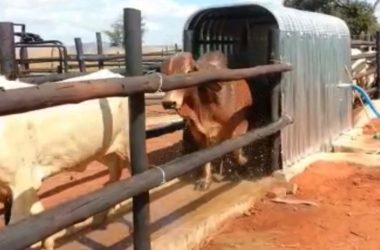THE United States Agency for International Development (USAID) has released US$2.2 million to the Food and Agriculture Organization of the United Nations (FAO) to finance a one-year emergency livestock project set up to mitigate the impact of livestock diseases and to improve household resilience.
The major challenges affecting Zimbabwe’s livestock sector include:
- Animal health, sanitary and food safety issues;
- Availability of adequate nutrition (feed, pastures, fodder and water) and water for livestock;
- Genetic improvement issues;
- Access to infrastructure suitable for accessing lucrative domestic, regional and international markets
- Inadequate financial resources
The project, titled: ‘Mitigating the Impact of Livestock Diseases’ is set to benefit from the experiences of key stakeholders in the animal health and livestock sector value chain who include FAO, Department of Veterinary Services (DVS), and private sector livestock sector player.
In his remarks at the launch of the project, Professor Obert Jiri, Permanent Secretary in the Ministry of Lands, Agriculture, Fisheries, Water and Rural Development said the livestock sector, like every other sector in Zimbabwe, has not been spared by the negative effects of the climate change, resulting in recurrent droughts, excessive temperatures, flash floods, midseason droughts.
“This has resulted in poor performance of the veld, degradation of the rangelands, low livestock immunity consequently occurrence of livestock diseases.
 “Poor nutrition is one of the major challenges affecting production and productivity of the livestock sector and its upstream and downstream industries. Performance of the veld, which forms the basic source of feed for grazing livestock, has been negatively impacted by the droughts materials,” Prof Jiri said.
“Poor nutrition is one of the major challenges affecting production and productivity of the livestock sector and its upstream and downstream industries. Performance of the veld, which forms the basic source of feed for grazing livestock, has been negatively impacted by the droughts materials,” Prof Jiri said.
“This initiative is very much welcome to the Ministry and to the rest of the Zimbabwean populace. It dovetails well into the objectives and goals of the economic blueprint, National Development Strategy 1 and is in keeping with the livestock growth plan which is crafted to address these challenges bedeviling the livestock sector,” he added.
The livestock sector, which contributes about 22% to Zimbabwe’s GPD with 87% of the cattle being in communal areas, Old Resettlement and A1 farming areas, has been under severe threat from tick-borne diseases, in particular theileriosis, or January Disease, which accounts for at least 60% of the reported deaths.
An emerging threat of a deadly strain of the transboundary Foot and Mouth Disease (serotype O) is also imminent following reported cases in neighboring countries such as Mozambique and Zambia. Tick-borne diseases (TBDs) have been by far the most economically debilitating group of cattle diseases accounting for about 67% of all cattle mortalities each year, according to a Department of Veterinary Services (DVS) October 2022 report.
The major factors that have fueled the spread of livestock diseases and mortality include; erratic dipping/ inadequate dipping of animals, late detection and response, illegal livestock/animal movements, limited availability of vaccines and poor animal nutrition.
The four main TBDs in Zimbabwe are Babesiosis, Anaplasmosis, Heartwater and Theileriosis. Among the four, Theileriosis or January disease has been the most widespread and devastating in the last 3 years, having been reported in 9 out of 10 provinces in the country; and accounting for over 60% of the thousands of TBD related mortalities in the country.
The project launched Thursday is expected to mitigate the impact of these diseases.
 “Today is an important day for the livestock sector in Zimbabwe as we officially launch this project in support of livestock development. In collaboration with the Government of Zimbabwe and with support from USAID, FAO is positioned to contribute to the improvement of animal health to make livestock more productive and sustainable while achieving optimal health for all,” said Patrice Talla, FAO Subregional Coordinator for Southern Africa and Representative in Zimbabwe, who was represented by Dr Berhanu Bedane, Livestock Development Officer at FAO.
“Today is an important day for the livestock sector in Zimbabwe as we officially launch this project in support of livestock development. In collaboration with the Government of Zimbabwe and with support from USAID, FAO is positioned to contribute to the improvement of animal health to make livestock more productive and sustainable while achieving optimal health for all,” said Patrice Talla, FAO Subregional Coordinator for Southern Africa and Representative in Zimbabwe, who was represented by Dr Berhanu Bedane, Livestock Development Officer at FAO.
Dr Bedane said FAO has contributed US$500,000 complimentary funding towards the project.
Zimbabwe Beef Producers Society Chairman, George Chiunda said the project ties in “very well” with his society’s objectives.
“Our society is focused on the small-scale farmers who face the burden of diseases. These linkages will beneficial to the farmers,” said Chiunda.
The society represents farmers and is a link between DVS and farmers
Dr Taurai Imbayarwo CEO of Mayin Waters, veterinary products producer, said that the project is an “incredible addition to existing efforts” to build resilience for rural farmers.
 “DVS in conjunction with FAO, launched a programme that focused on animal health sector which seeks to address the access of veterinary products to rural farmers. They decided to include the private sector where we did a pilot project to provide animal health products to rural farmers. This is against the background of a lot of medicines and veterinary products coming into the country that are unlicensed and are dangerous to livestock. The project aimed at mitigating this challenge. The access to veterinary products was also a challenge for rural farmers. Therefore, this project, Mitigating the Impact of Livestock Diseases dovetails with these running efforts,” said Dr Imbayarwo.
“DVS in conjunction with FAO, launched a programme that focused on animal health sector which seeks to address the access of veterinary products to rural farmers. They decided to include the private sector where we did a pilot project to provide animal health products to rural farmers. This is against the background of a lot of medicines and veterinary products coming into the country that are unlicensed and are dangerous to livestock. The project aimed at mitigating this challenge. The access to veterinary products was also a challenge for rural farmers. Therefore, this project, Mitigating the Impact of Livestock Diseases dovetails with these running efforts,” said Dr Imbayarwo.
Mayin Water manufactures veterinary products, looking at non-toxic products and antimicrobial products.
The project is expected to strengthen responses to control livestock disease outbreaks, thereby protecting livelihood assets, and promoting improved livestock nutrition to increase animal disease resistance.
Feedback: [email protected]
Mobile: +263 77 242 4997
Subscribe to Maricho Magazine: [email protected]










